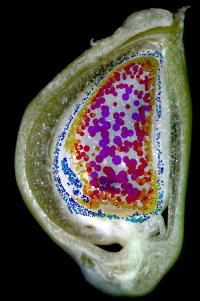
|  |  |  Editorials | Environmental | October 2009 Editorials | Environmental | October 2009  
The Amazing Maze of Maize Evolution
 Richard Hund - American Journal of Botany Richard Hund - American Journal of Botany
go to original
October 06, 2009


| | This is a longitudinal section of developing caryopsis of maize ancestor, teosinte. Study on maize domestication may help improve crop yields. (Ales Kladnik) |  |
Understanding the evolution and domestication of maize has been a holy grail for many researchers. As one of the most important crops worldwide and as a crop that appears very different from its wild relatives as a result of domestication, understanding exactly how maize has evolved has many practical benefits and may help to improve crop yields.

In the October issue of the American Journal of Botany, Dr. Marina Dermastia and colleagues published their research comparing corn kernel development to its closest wild relative: teosinte. This research overturns some commonly held beliefs on the domestication of maize because, unexpectedly, many traits seen in the cellular development of maize kernels that were previously attributed to the process of domestication were observed in the development of the teosinte kernels by Dermastia and her colleagues. "Although the teosinte kernels are morphologically so different from that of maize, their inside is not, Dermastia said. "Although we did not expect fundamental differences between maize and teosinte, the similarities were striking."

Some of the traits thought to be unique to maize but now also found in teosinte include an early programmed cell death for cells in part of the kernel and accumulation of phenolic and flavonoid compounds in the walls of these cells. These developmental changes strengthen the cells, protect them against decay and disease, and increase water conductance. According to Dermastia, "We suggested previously that this process was important for the establishment of the water and assimilate flow to the developing maize kernel…in the teosinte kernel, we not only detected programmed cell death…but also all other phenomena described as related to the transport into the maize kernel." The presence of these traits in teosinte kernels suggests that they are not a consequence of maize domestication.

Other developmental traits they observed in the teosinte kernels included the presence of an enzyme that controls the flow of sugar in the developing seed, which appears to be a common mechanism for sugar uptake in both maize and teosinte.

Dermastia and her colleagues did observe one difference between seed development in teosinte and maize. Endoreduplication, the process of a cell duplicating its DNA without subsequent cell division, is a phenomenon that occurs in the endosperm of cereals, which is the nutritious part of the seed. An increasing rate of endoreduplication results in cells with greater DNA content and, subsequently, increased gene expression and greater sink capacity for the developing seed. Dermastia and her colleagues observed that the distribution of cells with high DNA content in maize differs from that of teosinte. In maize, these cells are found in the upper part of the endosperm, while in teosinte they are distributed throughout the endosperm. The researchers hypothesize that this difference may be related to more efficient starch deposition in maize as a result of domestication.

"Our study indicates that the main differences, beside the teosinte fruitcase and its absence in maize, might lay in the process of endoreduplication in endosperm, Dermastia said. "Knowing the process in more depth might be an important step in improving a most important crop."

The full article in the link mentioned is available for no charge for 30 days following the date of this summary HERE. After this date, reporters may contact Richard Hund at ajb@botany.org for a copy of the article.

The Botanical Society of America (www.botany.org) is a non-profit membership society with a mission to promote botany, the field of basic science dealing with the study and inquiry into the form, function, development, diversity, reproduction, evolution, and uses of plants and their interactions within the biosphere. It has published the American Journal of Botany (www.amjbot.org) for nearly 100 years. In 2009, the Special Libraries Association named the American Journal of Botany one of the Top 10 Most Influential Journals of the Century in the field of Biology and Medicine.

For further information, please contact the AJB staff at ajb(at)botany.org. |

 |
|  |



